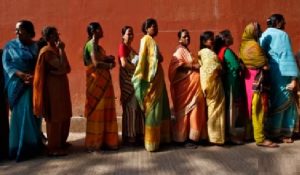06-05-2024
Bureau Report + Agencies
NEW DELHI: Just weeks before the first ballot was cast in this year’s Indian election, Prime Minister Narendra Modi was at an event in Delhi rubbing shoulders with people known by names like BeerBiceps and Curly Tales.
The event, an awards show, congratulating some of the country’s top social media stars on their work was an acknowledgement of the power of the influencer which a few years ago may have seemed unimaginable and as  politicians prepared to battle it out for India’s billion votes, these influencers were being lined up to play a crucial role in reaching the young, the disinterested and the disillusioned but even as some celebrate social media’s democratization of the media, a place where any one can share their views freely others paint a darker picture, one where threats are rife, and the truth can be set aside for the right pay cheque.
politicians prepared to battle it out for India’s billion votes, these influencers were being lined up to play a crucial role in reaching the young, the disinterested and the disillusioned but even as some celebrate social media’s democratization of the media, a place where any one can share their views freely others paint a darker picture, one where threats are rife, and the truth can be set aside for the right pay cheque.
A decade ago, you would have struggled to find anyone calling themselves an “influencer” but now, says Vinay Deshpande, co-founder of Rajneethi, a political management consultant firm, “it’s become a profession”.
“I know teenagers who are doing this part-time to earn pocket money.”
Pocket money underplays the earning potential somewhat.
However, at the lower end, people can charge around 2,000 rupees ($24; £19) a day, but top influencers can pull in about 500,000 rupees for a post equivalent to the monthly salary of someone in top-level management.
The creator of the Ranting Gola channel revealed to media that political parties and election management firms have offered as much as “100,000 to 500,000 rupees for a single campaign”.
It is no small amount but then, it could turn the tide in a candidate’s favor.
Deshpande says they have helped an opposition candidate win an assembly election by pushing out content through a curated list of local influencers with a small but active following.
“Social media content is powerful and can influence the way a person feels about an issue,” Deshpande says. “It gives social currency to a belief or opinion but this can lead to a lack of critical thinking about an issue,” he adds.
 Preethi Aggarwal, 25, is one of those who turns to apps like Instagram, YouTube and Twitter to help her understand the news.
Preethi Aggarwal, 25, is one of those who turns to apps like Instagram, YouTube and Twitter to help her understand the news.
Like thousands of others, Aggarwal follows a bunch of “political influencers”, or people who talk about politics on social media to “really understand what’s going on”.
“News can get boring and complicated sometimes. I think these people (influencers) make it fun and easier to understand,” she says, adding the context and their own perspective help her form her opinions but the problem is, whose perspective is she getting?
YouTuber Samdish Bhatia reveals numerous politicians have reached out to him, especially in the months before this election, offering him millions of rupees to interview them but “they wanted me to share questions in advance or get the video approved before it’s published,” he says, adding that he declined the offers because he “likes to maintain editorial control”.
The particular trend for longer form, slightly chummy interviews where politicians get to show off their human side – is particularly vulnerable to management, says Joyojeet Pal, an associate professor at the University of Michigan.
“Many of these interviews are carefully managed by politicians,” Pal says but even if they aren’t, a gentler style of questioning can also blur the line between interview and promotion, says Pal.
 Pressmediaofindia
Pressmediaofindia




